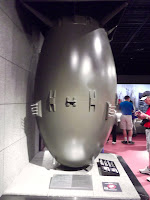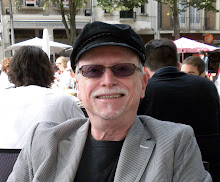I don't pretend to understand the Resnais/Duras film Hiroshima mon amour, (which I saw many years ago and only dimly recall as "not making much sense.") The critics, though, say that this film is a meditation on the role of memory in reconciliation and reconstruction--of both a bomb-devastated city and an emotionally shattered woman.
 I thought a lot about that "memory stuff" when I visited Nagasaki last autumn. Just how "healing" is memory? And just how does "what we remember" shape the nature of our reconstruction?
I thought a lot about that "memory stuff" when I visited Nagasaki last autumn. Just how "healing" is memory? And just how does "what we remember" shape the nature of our reconstruction? An individual's memory is, of course, selective--and never entirely factual. As Proust and others have shown, we remember what we need or want to remember, altering this and that and, in the end, weaving together objective and subjective "truths" into a narrative fabric that provides a past that we find personally constructive and necessary. We use memory to shape a reality that perhaps never "was" but that for some reason necessarily "is."
So it is, also, perhaps, with a nation's collective memory--or, as Nagasaki demonstrates, with the collective memories of several nations, most notably of Japan and the United States.
How initially odd, it seemed, on the day of our Nagasaki visit, to be an American, a countryman of both those who ordered the bombing and those who carried out the lethal mission. But my initial discomfort dissipated quickly. Everywhere we visited--the Peace Park, the Ground Zero site, the Museum, the various Monuments to the Victims--everywhere, there were crowds of tourists (most, it seemed, English-speaking) AND cohort after cohort of school children (all Japanese, of course). And everyone was evaluating the sights quite comfortably, I thought, probably according to a "memory" constructed either personally or "officially", some long-internalized narrative about the Meaning of Nagasaki. (Actually, in the case of the schoolkids, the narratives were probably even then being transmitted to their brains from the already well-honed and by now comfortably "digested" memories stored in the teachers' nervous systems.)
Alas, it seems to me now--in retrospect--that the supposed "lesson" of Nagasaki is considerably weakened by this very understandable human tendency to refine memories--like we refine flour--in ways that make them more "digestible." Because I can't avoid thinking that Nagasaki, the supposed monument to a monstrous-evil-that-must-not-be-repeated has somehow been transformed into a Shrine of MisRemembrance--a nicely sanitized tourist attraction. Oh, don't get me wrong: the museum contains numerous artfully arranged, carefully documented, and technologically sophisticated exhibits. Outside, the Peace Park, blessedly free of T-shirt souvenir stands, comprises tastefully designed flower beds, sculptures and fountains. But the very beauty and serenity of the place seemed to make a mockery of its avowed purpose: to horrify mankind with memories so intolerable that never again will we allow such inhumanity to occur.
In short, the Peace Park, Museum, Ground Zero--all were so remarkably tolerable and "digestible" that they reminded me strongly of a Japanese bento box lunch, so pretty that the actual taste of the food is of secondary importance. As the Japanese kids scurried laughingly to take group pictures in front of the monolithic Ground Zero marker, the American tourists seemed to gravitate toward the life-sized mock-up of the bomb itself, where they enthusiastically photographed family members saying "cheese" in front of the innocuous-looking "Fat Man." I, too, took exactly such photos.
I conclude, then, that our collective memories--which both produced and are reinforced by this memorial complex--are somehow deliberately, (perhaps necessarily?), MISremembering what happened here--almost as if we, Americans and Japanese alike, are telling ourselves "well, yes, it happened, but not exactly."
 So I return to my initial question. How does that work, precisely? How does memory "reconstruct" reality and transform what was intended to be an unbearably painful Memorial to Human Evil into a pleasant School Field Trip and/or Popular Shore Visit?
So I return to my initial question. How does that work, precisely? How does memory "reconstruct" reality and transform what was intended to be an unbearably painful Memorial to Human Evil into a pleasant School Field Trip and/or Popular Shore Visit?I suspect that the collective Japanese memory is a composite of shame, horror, sorrow but, interestingly, very little anger. And this memory, oddly, manifests itself in a kind of "perkiness"--a refusal to think too deeply about it all, a collective denial that "it" was really EVIL. The school children, of course, scrambled about happily, polite but clearly more fascinated by the destructiveness than by what had been destroyed. And after leading us through the museum--full of gruesome and startling mementoes, our pink-umbrella'ed guide cheerfully conducted us back to the bus, where she immediately mounted an amateurish little puppet show to teach us how to make souvenir "peace"cranes. The take-away message: very sad, must not happen again, but no one was EVIL, everything "happened, sorta" because of circumstances.
Meanwhile, many of us Americans were engaging in our own forms of selective and reconstructive remembering. Our awareness of Nagasaki--less deep than that of the Japanese, and derived mostly from half-watched TV and half-read high school history books--probably included sorrow and sympathy, perhaps some national pride, but little sense of guilt or responsibility. So we Americans, too, visited each of the regular Nagasaki "stations of the cross", snapped our pictures--but refused to believe that we--America--had done an EVIL thing. Similar take-away message: very sad, must not happen again, but no one was EVIL, everything "happened, sorta" because of circumstances.
In both cases, then, it seems to me that our national memories have constructed a kind of bad faith "reality"--a narrative that comforts, that allows reconciliation and business dealings, but (perhaps for that very reason) will NOT accomplish the stated goal of the Nagasaki shrine: to prevent this from happening again. As long as the "evil" of war --and of nuclear weapons--is neither felt deeply nor even fully acknowledged by the visitors, the pious admonitions beneath the "nuclear proliferation" exhibit serve only to underline our nearly universal phariseeism and hypocrisy.
 In any event, as I left the Peace Park (and especially as I giggled in spite of myself at the guide's absurd puppet show) I felt a sudden wave of revulsion. This whole place, I thought briefly, was itself "evil"-- designed to make the visitor feel good about feeling bad, to make us feel OK about stuff that, you know, "happened, sorta" way back in 1945, but that, gosh, even the puppets know this, will never happen again.
In any event, as I left the Peace Park (and especially as I giggled in spite of myself at the guide's absurd puppet show) I felt a sudden wave of revulsion. This whole place, I thought briefly, was itself "evil"-- designed to make the visitor feel good about feeling bad, to make us feel OK about stuff that, you know, "happened, sorta" way back in 1945, but that, gosh, even the puppets know this, will never happen again.Then the nausea passed as quickly as it had come, and, as the bus rocked soothingly along, returning us to the cruise ship and to "real" reality, I unexpectedly dozed off. I suppose I had been healed: less by my memories themselves than by their juxtaposition with the guide's incongruous puppet show. Nagasaki mon amour.


No comments:
Post a Comment